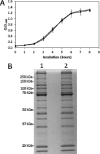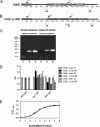Use of the chinchilla model for nasopharyngeal colonization to study gene expression by Moraxella catarrhalis
- PMID: 22184412
- PMCID: PMC3294655
- DOI: 10.1128/IAI.05918-11
Use of the chinchilla model for nasopharyngeal colonization to study gene expression by Moraxella catarrhalis
Abstract
Young adult chinchillas were atraumatically inoculated with Moraxella catarrhalis via the nasal route. Detailed histopathologic examination of nasopharyngeal tissues isolated from these M. catarrhalis-infected animals revealed the presence of significant inflammation within the epithelium. Absence of similar histopathologic findings in sham-inoculated animals confirmed that M. catarrhalis was exposed to significant host-derived factors in this environment. Twenty-four hours after inoculation, viable M. catarrhalis organisms were recovered from the nasal cavity and nasopharynx of the animals in numbers sufficient for DNA microarray analysis. More than 100 M. catarrhalis genes were upregulated in vivo, including open reading frames (ORFs) encoding proteins that are involved in a truncated denitrification pathway or in the oxidative stress response, as well as several putative transcriptional regulators. Additionally, 200 M. catarrhalis genes were found to be downregulated when this bacterium was introduced into the nasopharynx. These downregulated genes included ORFs encoding several well-characterized M. catarrhalis surface proteins including Hag, McaP, and MchA1. Real-time reverse transcriptase PCR (RT-PCR) was utilized as a stringent control to validate the results of in vivo gene expression patterns as measured by DNA microarray analysis. Inactivation of one of the genes (MC ORF 1550) that was upregulated in vivo resulted in a decrease in the ability of M. catarrhalis to survive in the chinchilla nasopharynx over a 3-day period. This is the first evaluation of global transcriptome expression by M. catarrhalis cells in vivo.
Figures





Similar articles
-
Identification of an outer membrane lipoprotein involved in nasopharyngeal colonization by Moraxella catarrhalis in an animal model.Infect Immun. 2014 Jun;82(6):2287-99. doi: 10.1128/IAI.01745-14. Epub 2014 Mar 18. Infect Immun. 2014. PMID: 24643539 Free PMC article.
-
Contribution of Moraxella catarrhalis type IV pili to nasopharyngeal colonization and biofilm formation.Infect Immun. 2007 Dec;75(12):5559-64. doi: 10.1128/IAI.00946-07. Epub 2007 Oct 1. Infect Immun. 2007. PMID: 17908808 Free PMC article.
-
Use of the Chinchilla model to evaluate the vaccinogenic potential of the Moraxella catarrhalis filamentous hemagglutinin-like proteins MhaB1 and MhaB2.PLoS One. 2013 Jul 2;8(7):e67881. doi: 10.1371/journal.pone.0067881. Print 2013. PLoS One. 2013. PMID: 23844117 Free PMC article.
-
Molecular aspects of Moraxella catarrhalis pathogenesis.Microbiol Mol Biol Rev. 2009 Sep;73(3):389-406, Table of Contents. doi: 10.1128/MMBR.00007-09. Microbiol Mol Biol Rev. 2009. PMID: 19721084 Free PMC article. Review.
-
Virulence determinants of Moraxella catarrhalis: distribution and considerations for vaccine development.Microbiology (Reading). 2017 Oct;163(10):1371-1384. doi: 10.1099/mic.0.000523. Epub 2017 Sep 12. Microbiology (Reading). 2017. PMID: 28893369 Review.
Cited by
-
Competition among Nasal Bacteria Suggests a Role for Siderophore-Mediated Interactions in Shaping the Human Nasal Microbiota.Appl Environ Microbiol. 2019 May 2;85(10):e02406-18. doi: 10.1128/AEM.02406-18. Print 2019 May 15. Appl Environ Microbiol. 2019. PMID: 30578265 Free PMC article.
-
Identification of an outer membrane lipoprotein involved in nasopharyngeal colonization by Moraxella catarrhalis in an animal model.Infect Immun. 2014 Jun;82(6):2287-99. doi: 10.1128/IAI.01745-14. Epub 2014 Mar 18. Infect Immun. 2014. PMID: 24643539 Free PMC article.
-
A Moraxella catarrhalis two-component signal transduction system necessary for growth in liquid media affects production of two lysozyme inhibitors.Infect Immun. 2015 Jan;83(1):146-60. doi: 10.1128/IAI.02486-14. Epub 2014 Oct 13. Infect Immun. 2015. PMID: 25312959 Free PMC article.
-
Panel 4: Report of the Microbiology Panel.Otolaryngol Head Neck Surg. 2017 Apr;156(4_suppl):S51-S62. doi: 10.1177/0194599816639028. Otolaryngol Head Neck Surg. 2017. PMID: 28372529 Free PMC article. Review.
-
The Moraxella catarrhalis phase-variable DNA methyltransferase ModM3 is an epigenetic regulator that affects bacterial survival in an in vivo model of otitis media.BMC Microbiol. 2019 Dec 9;19(1):276. doi: 10.1186/s12866-019-1660-y. BMC Microbiol. 2019. PMID: 31818247 Free PMC article.
References
Publication types
MeSH terms
Associated data
- Actions
Grants and funding
LinkOut - more resources
Full Text Sources
Molecular Biology Databases

